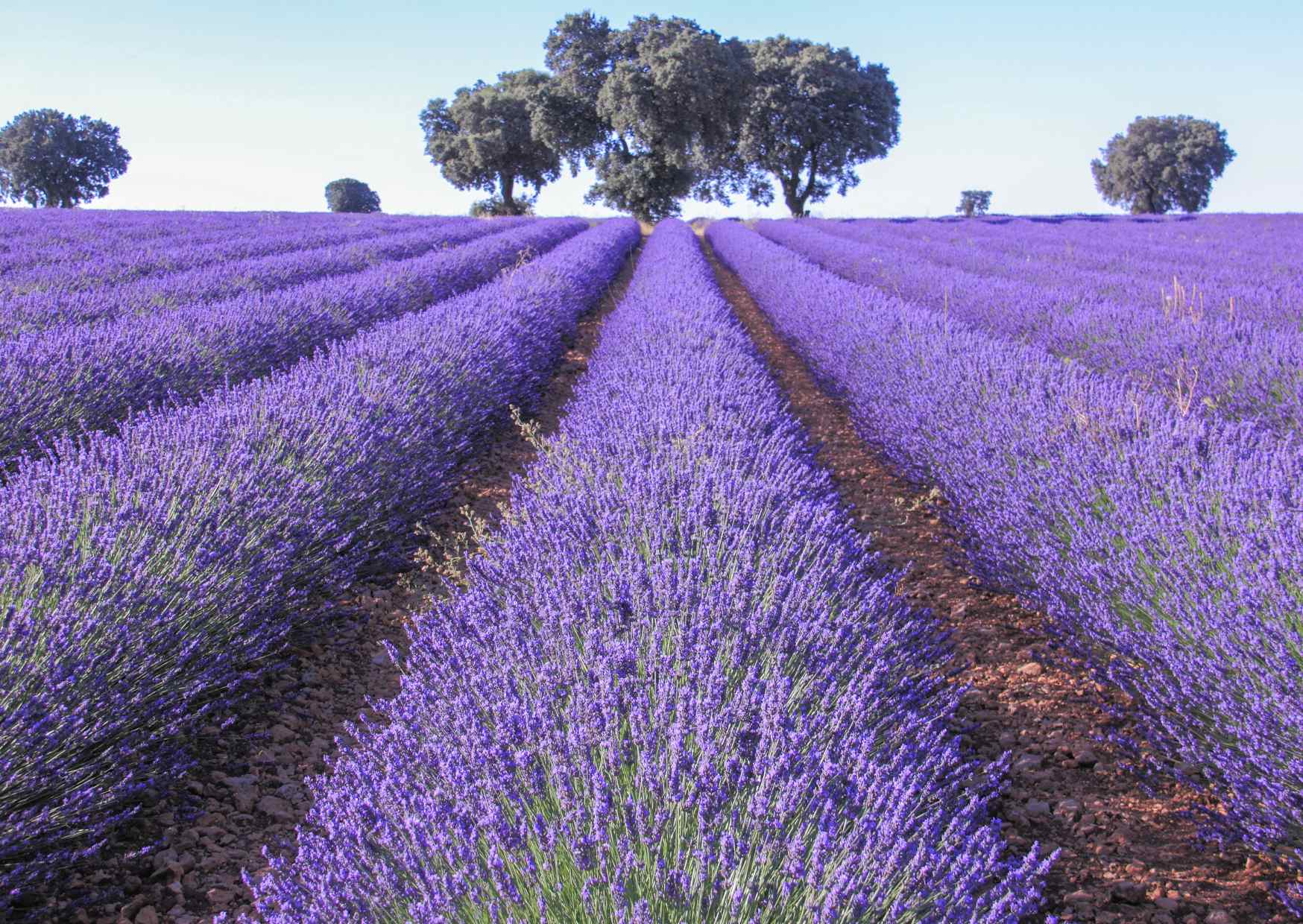The majestic beauty and surefire intuition that horses possess is remarkable. As children, many of us stand in awe of them gracefully grazing in a pasture. And as adults, not much has changed. For anyone who is fortunate enough to care for these creatures, their overall health is of utmost importance. And if you’re looking for natural, holistic therapies for your horse, essential oils may be a perfect match! Aromatherapy can support the emotional and physical needs of horses, including issues such as nervousness, spooking, skin problems, wound care, and grooming needs.
Professionals who practice equine aromatherapy take careful consideration of how certain essential oils can work to benefit the health needs of horses. Collectively, it has been determined that many of the oils, blends, and techniques used for canines are the same that can be used for horses! The primary difference is that a horse, being much larger than a dog, can tolerate a higher dilution rate.
First, let’s learn some general info about a horse’s sense of smell!
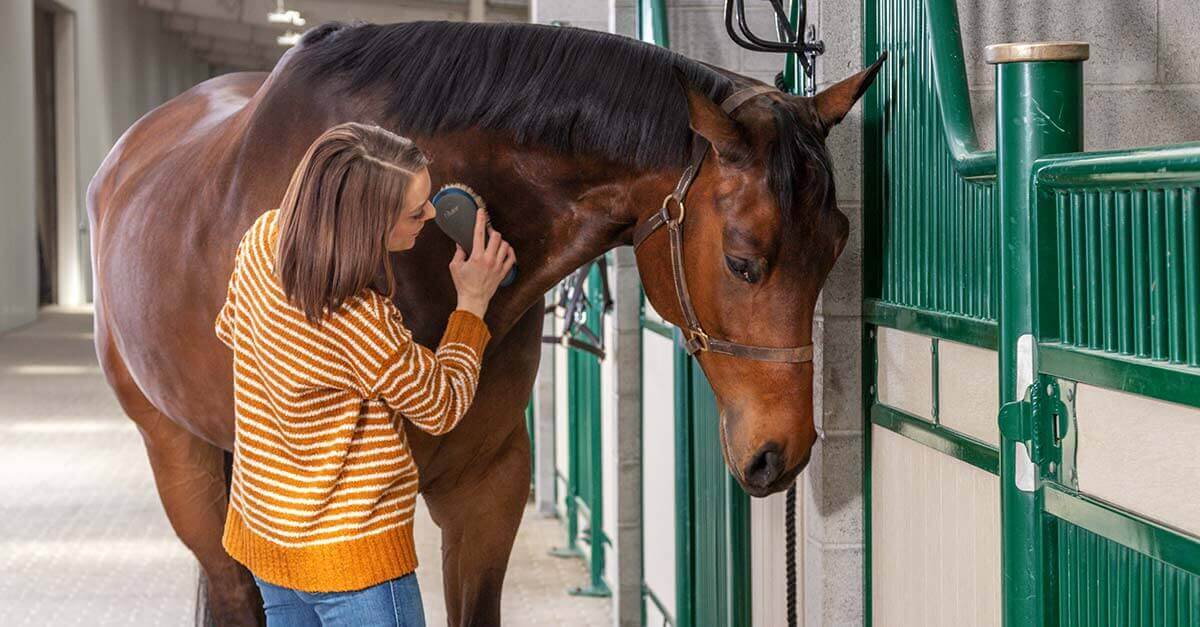
It’s important to realize that horses, like many other animals, have a large nasal cavity and a keen sense of smell. It is thought that the horse’s sense of smell is thousands of times more powerful and sensitive compared to that of a person! Scent recognition plays a huge role in the life of a horse. According to David Whitaker, PhD, from Middle Tennessee State University, the importance of a horse’s sense of smell has even been compared to the importance of language to human beings.
Horse’s have their olfactory receptors located in the upper portion of their nasal cavity. This allows the receptor cells to have more time for analysis as the scent molecules to travel through the nasal cavity. Horses can also flare their nostrils to take in more scents, which is known as the flehmen response. Also called the “horse laugh,” the flehmen response traps scent molecules within the nasal cavity. This allows the horse to analyze the scent more closely by closing the nostrils to trap the scent and closing off the airway.
So where do we start?
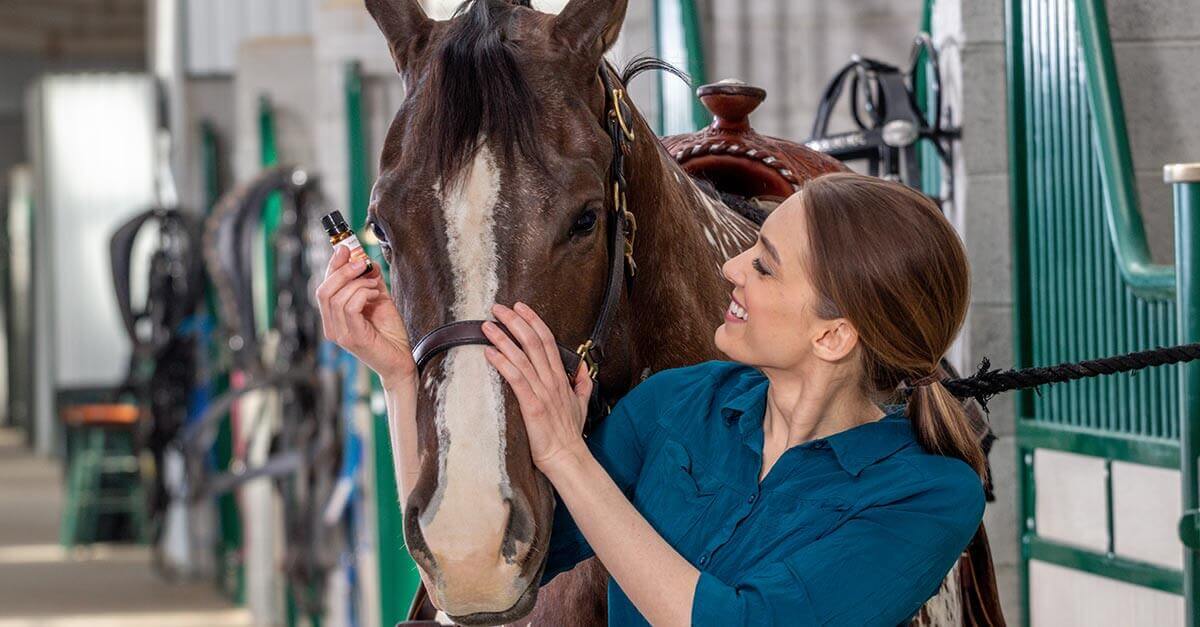
Because of a horse’s sophisticated sense of smell, introducing essential oils to them gradually is the key to success. You’ll want to focus on creating a positive association with the oil or blend you want to try. This positive association will not be made if you force oils on your horse without giving them the autonomy to choose for themselves.
To begin, choose the Pup & Pony blend you would like to use on your horse. Dilute to our recommended dilution for horses, which is 1-2%. Then rub the diluted blend on your palms and present your palms to your horse. Simply presenting your palms gives your horse the opportunity to smell the blend and provide you with either a positive, negative, or indifferent response. If you notice a positive response, continue this technique for a few days. That way, your horse will begin to associate the chosen blend’s lovely aroma with their most favorite person—you! Once your horse has demonstrated their appreciation of the blend, you can move forward to diffusion and topical inhalation.
Some signs of acceptance include your horse showing an interest in the oil, a willingness to continue inhalation of the oil, and visible relaxation. Some signs of an aversion to an oil include walking away from the aroma, an aggressive emotional response, pacing, turning head away, or showing respiratory distress.
All horses are different and these lists are not all-inclusive. Basically, you are looking for out-of-the-ordinary behaviors from your horse to help determine if he or she is accepting or rejecting the essential oil or blend. Horses are incredibly intuitive and seem to have an uncanny sense of what is best for them.
DOs & DON’Ts
- DO start slowly and watch for a reaction.
- DON’T present undiluted essential oils to your horse.
- DO apply the oil to yourself for the first few days before applying to your horse.
- DON’T force essential oils on your horse if they show aversion. This may lead to a negative emotional reaction.
- DO be familiar with your horse’s current health issues and speak with a veterinarian to help decide if using EOs is the right choice.
- DON’T add essential oils to your horse’s food or water.
- DO start with the lowest recommended dilution.
Pup & Pony to the rescue!
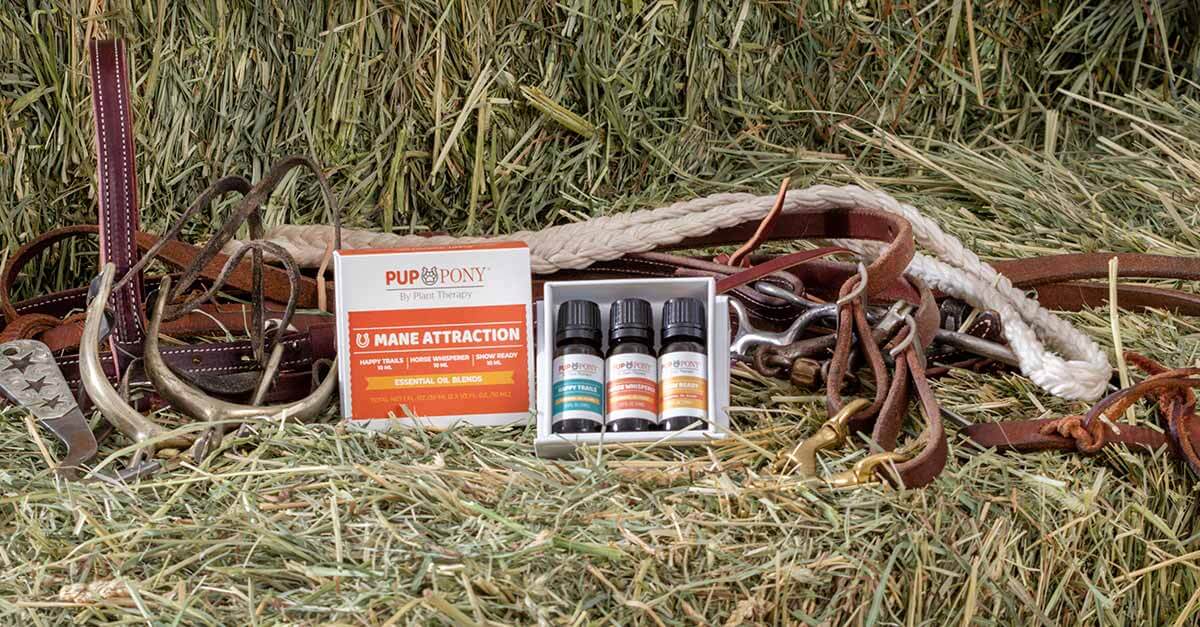
Take a look at our horse (and dog!) friendly blends:
Confident K9: Confident K9 was formulated for dogs who struggle with being alone. It helps promote relaxation, support doggy confidence, and soothe worry. Whether it’s excessive barking or shaking to chewing on belongings or clawing at your front door, Confident K9 can help! While Confident K9 was created specifically with dogs in mind, it is also safe and effective for horses who may struggle with similar issues.
Happy Trails: Happy Trails was created to make traveling easier for your dogs and horses. Our four-legged friends can experience motion sickness during travel just like humans. This blend’s scent is soothing to your animal’s upset stomach, and also works to comfort your animals so they stay calm and worry-free.
Horse Whisperer: Just like humans, dogs and horses can develop fear and anxiety disorders after a traumatic experience. Trauma is especially common in rescue animals but also occurs during events we may not normally consider, such as forced weaning, continuous use of ill-fitting tack, etc. This blend helps to calm and comfort animals while supporting their emotional healing process. While Horse Whisperer was created specifically with horses in mind, it is also safe and effective for dogs who may struggle with similar issues.
Show Ready: Show Ready was created to keep your dogs and horses healthy. Dogs and horses become more susceptible to illness and disease during times of travel, stress, when being boarded for long periods of time, or when exposed to other ill or unfamiliar animals. This blend utilizes essential oils that will help to support the immune system and offer protection from illness.

When actively diffusing, we recommend using an ultrasonic type of diffuser (like the NovaFuse, UltraFuse, & AromaFuse). Use 1-2 drops per 100 mL of water and begin diffusing for 5 to 10 minutes every few hours. This allows you to determine how your horse will react to the aroma permeating the air. Remember, your horse is so much more sensitive to scents than you are and a little bit goes a long way!
We recommend that you diffuse in a well-ventilated area that your horse is able to leave if he or she wants to. Avoid continuous diffusion and immediately discontinue use if you notice any kind of negative reaction. Also, ensure the diffuser is out of the horse’s reach to prevent them from knocking it over and spilling undiluted EOs on themselves.
If you’d like to try passive diffusion techniques, your horse may enjoy the Paw Pal Diffuser being clipped inside their stable. Please note that when using passive diffusion we recommend diluting the EO as if you were applying topically. Do not use undiluted essential oils near your horse.
How to use EOs topically on your horse.
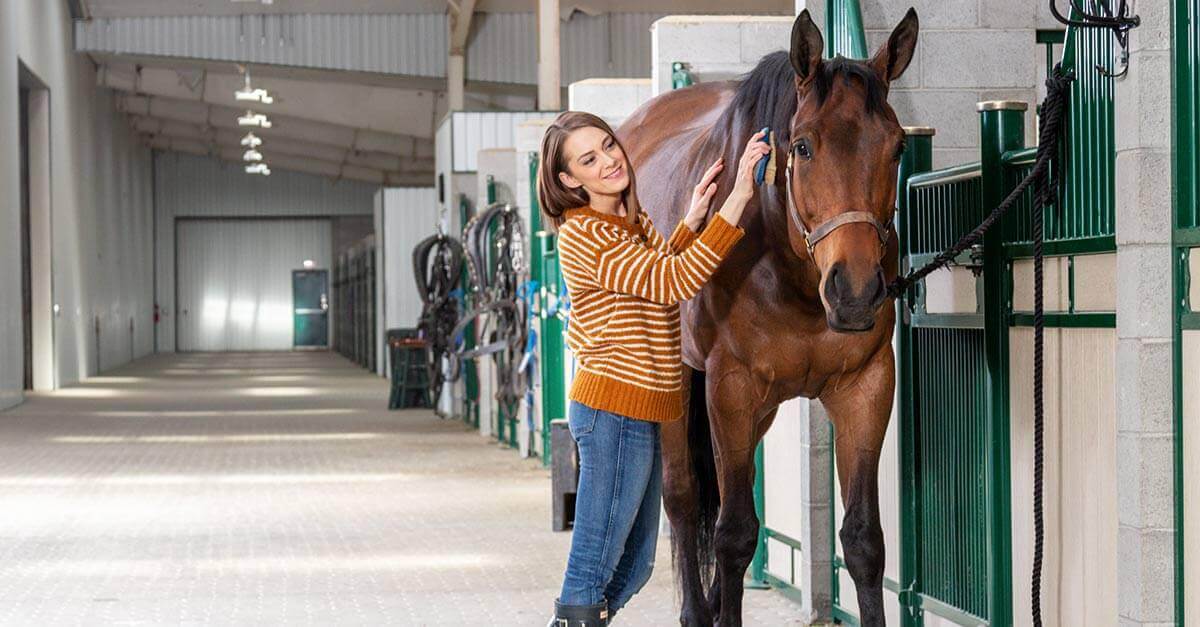
To help support issues ranging from emotional distress to skin care needs, topical application to the suggested areas of application may be very helpful! Apply the accepted essential oil or blend ideally while doing an activity your horse enjoys. Each horse is unique, but a few suggestions include applying it during massage applications, while grooming, or even when giving them their favorite treat. Positive reinforcement is critical to the success of using EOs with horses. Never apply directly to the mouth, muzzle, nose, nostrils, ears, eyes, or sensitive genital areas.
Plant Therapy’s Dilution Guidelines for horses:
- 1-2%
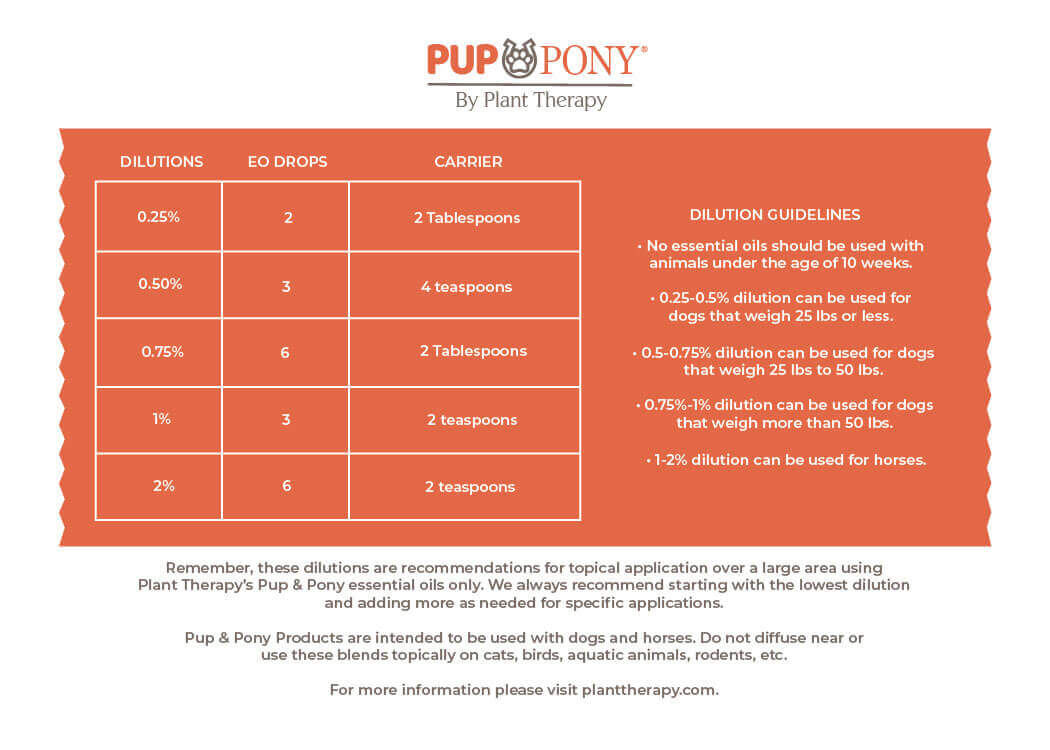
Areas of application:
- Back of neck
- Chest
- Upper inner foreleg (horse armpit!)
- Abdomen
Remember, this dilution is recommended for topical application over a large area using Plant Therapy’s Pup & Pony essential oils only. We always recommend starting with the lowest dilution and adding more as needed for specific applications.
Horse-Safe Essential Oils:
We recommend our Pup & Pony Blends, which include only safe essential oils. These were carefully formulated with your horse in mind and cover a wide variety of both physical and emotional issues.
Safe single oils include Bergamot, Cedarwood (all varieties), Chamomile (all varieties), Frankincense (all varieties), Lavender, Mandarin, Palmarosa, Sweet Orange, Sandalwood (all varieties), and Vetiver.
Essential oils to avoid include Anise, Birch, Blue Tansy, Camphor, Clove, Garlic, Oregano, Tea Tree, Wintergreen, and Yarrow.
Plant Therapy’s Pup & Pony line was created to provide a safe, natural, and effective method for supporting our beloved four-legged friends on their journey to emotional and physical well-being. We understand and have fully experienced the therapeutic properties of essential oils with humans and now, after undergoing extensive research, we are excited to extend the same benefits to our animal companions in a safe and efficacious manner.
Final thoughts to keep in mind…
Since horses are such large and powerful animals, one might think that they can handle large doses of essential oils. However, their powerful sense of smell, along with their inability to fully communicate to us how they feel, leads PT to encourage only safe and highly diluted EOs for them. Please talk with an equine veterinarian immediately if you suspect any health concerns after using essential oils.
Want to learn more about Pup & Pony? Well, you’re in luck! In this Plant Therapy Live video, recorded on April 12, 2019, Emilee Hughes (Certified Aromatherapist and the brains & beauty behind this new line!) and Retha Nesmith (Certified Aromatherapist and VP of Customer Experience) talk all about the blends, Paw Balm, and Paw Pal Diffuser, plus all kinds of customer questions! Watch below:
Interested in learning more about aromatherapy use with horses? Check out these books by one of the world’s foremost equine aromatherapists, Catherine Bird: Horse Scents: Making Sense with Your Horse Using Aromatherapy and A Healthy Horse the Natural Way.
For questions regarding essential oils for horses, please contact our Customer Service Team at CS@planttherapy.com. Your inquiry will be directed to our Certified Aromatherapists who have undergone specialized animal aromatherapy training.
Learning lots from our animal series? We sure hope so! Make sure to head over to our Safe Essential Oils Recipe group on Facebook to share your experiences!
Information collected from the following sources:
Bell, K.L. (2002). Holistic Aromatherapy for Animals: A Comprehensive Guide to the Use of Essential Oils & Hydrosols with Animals. Findhorn Press.
Morag, N. (2011). Essential Oils for Animals: Your Complete Guide to Using Aromatherapy for Animal Health and Management. Off The Leash Press.
Horses Rely on Their Five Senses. (2014). Retrieved from https://hubpages.com/animals/Horses-and-Their-Sense-of-Smell
Briggs, K. (2013). Equine Sense of Smell: Horses rely far more on chemical messages in the air than on their relatively indistinct eyesight. Retrieved from https://thehorse.com/13971/equine-sense-of-smell/
Blocksdorf, K. (2018). Understanding Your Horse’s Sense of Smell. Retrieved from https://www.thesprucepets.com/understanding-horses-sense-of-smell-1885781
Horse’s Sense of Smell. (n.d). Retrieved from http://www.horse-of-dream.vsau.ru/inter/smell-e.html
Animal Aromatherapy Foundation Course with Kelly Azzaro
Practical Aromatherapy for Dogs Certification
Veterinary Medical Aromatherapy with Dr. Nancy Brandt
